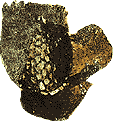


This page uses Netscape 2.0x features
Well, at least for the Northern Hemisphere!
Let's call it Autum special for the Southern Hemiphere folks!
The webmaster only knows too well by own experience that springtime and pollen is strongly related. ATISHOO!!! This must have been similar at least since the Late Carboniferous (some 300 million years ago) when the conifers (pine trees) arose. Springtime pollen must have particularly increased - ATISHOO!!! HATSCHI!!!! - from the Late Cretaceous (about 90 million years ago) onwards due to the rise of the modern flowering plants (angiosperms).
Flowers and even pollen are well preserved in the Messel oilshale, a lake deposit from the Lower Tertiary (ca. 45 million years old) situated to the south of Frankfurt am Main (Germany) and famous for its perfect preservation of many fossils:
Thanks to Jens Boysen, Frankfurt, for correcting my mistake in originally positioning Messel to the north of Frankfurt. Am I growing old?
These are flowers from the Lower Tertiary of Messel:
 |
 |
 |
| Flower of the extinct group Rutaceae | Blossom of a palm tree | water lily from the Messel lake |
This is a vine pollen from the Messel deposits, quite well preserved and almost 'alive':

Animated only under Netscape 2.0 or higher. Stop button of browser stops animation
Java-users: You may have a look at an even more exited tumbling pollen!
Here are some more nicely preserved pollen from the Lower Tertiary of Messel:




Tertiary pollen of a sea-lily
Tertiary pollen of Mastixiaceae
Tertiary pollen of walnut
an aggregate of Tertiary pollen
What is the impact of pollen on geology and palaeontology?
Pollen are frequently preserved in Ancient terrestrial deposits and allow to determine the relative ages of these. This makes them a great helper even in finding petroleum. Well, this is known since long, but
![]() here are our latest research results on
here are our latest research results on
the impact of these nasty nose ticklers on evolution!